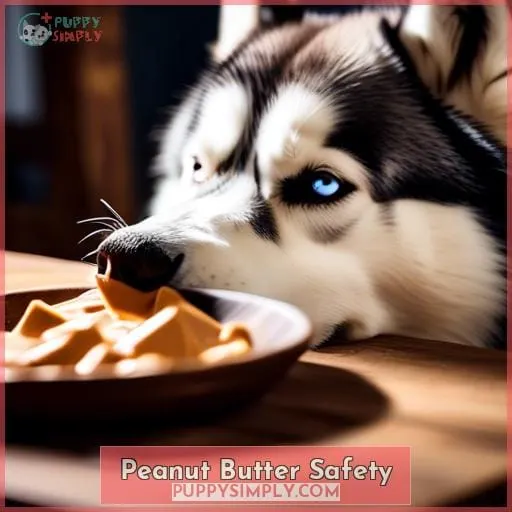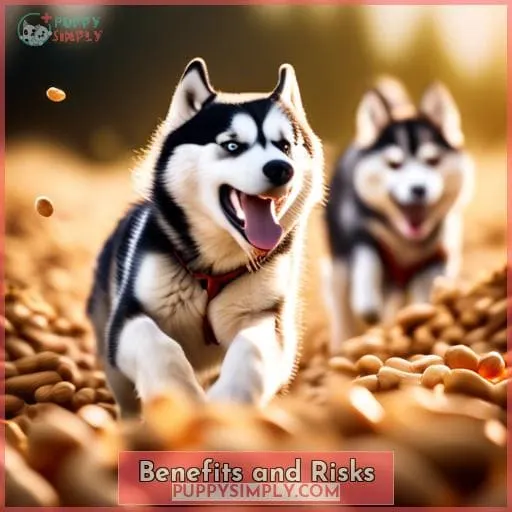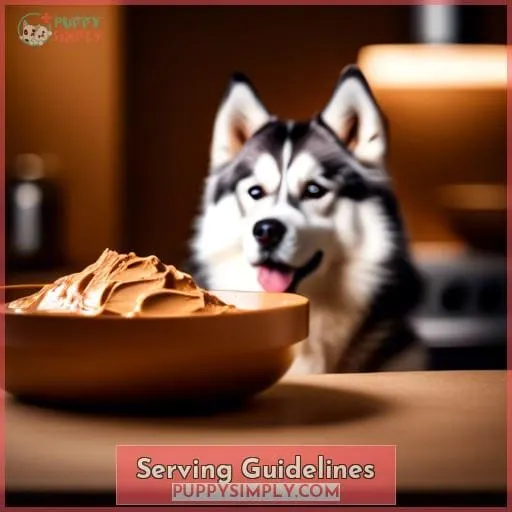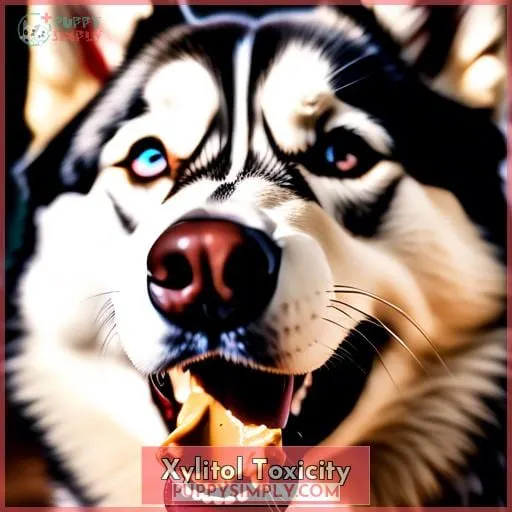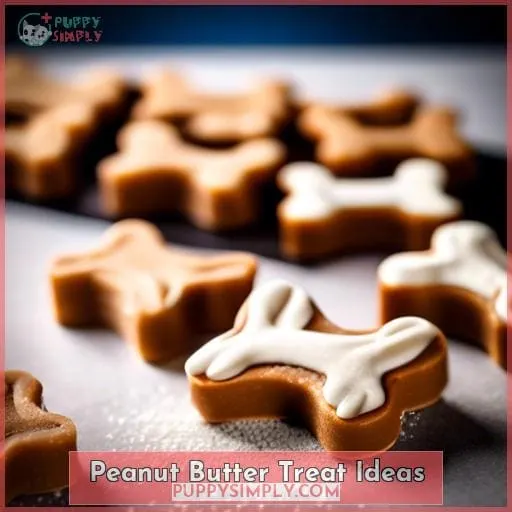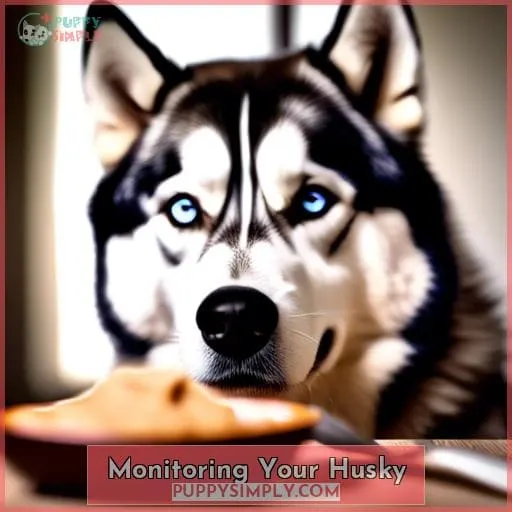This site is supported by our readers. We may earn a commission, at no cost to you, if you purchase through links.

The short answer is yes, huskies can eat peanut butter in moderation as an occasional treat, as long as it’s xylitol-free.
But there’s more to the story, so read on to learn the health benefits and risks of feeding your furry friend this tasty spread.
Let’s dig in to find the right serving size to avoid problems down the road.
With some care and common sense, peanut butter can be part of a balanced diet for your pup.
Table Of Contents
Key Takeaways
- Confirm peanut butter does not contain xylitol before giving it to huskies to avoid toxicity
- Give huskies peanut butter in moderation as an occasional treat, following the 10% rule for calories
- Monitor for symptoms like weakness or seizures if xylitol ingestion is suspected and contact a vet immediately
- Consider healthier alternatives like fruits and vegetables instead of peanut butter for regular treats
Peanut Butter Safety
When considering peanut butter for your husky, it’s crucial to identify safe types.
Many commercial peanut butters contain xylitol, which is extremely toxic to dogs.
Always check the ingredients list and avoid products with this dangerous sweetener.
Identifying Safe Types
Although hus can enjoy peanut butter, you’ll need to ensure you choose a brand that’s suitable for dogs.
Consider options like natural, unsweetened peanut butter varieties or making your own varieties to control ingredients.
When looking at store-bought peanut butter, choose ones designed especially for dogs that highlight their nutritional profile.
If making your own peanut butter, let you use all-natural ingredients while avoiding additives or sweeteners like xylitol.
Regardless of which you choose, peanut butter should only be an occasional treat for hus, not a staple.
Xylitol Alert
You’ll need to check peanut butter labels for xylitol, an artificial sweetener toxic to dogs.
Xylitol is found in many products like gum, breath mints, and vitamins.
When ingested by canines, it can cause severe health issues stemming from a dangerous insulin spike and hypoglycemia.
The toxicity can arise rapidly, within 10-60 minutes of consumption.
Sadly, xylitol poisoning cases are on the rise as manufacturers increasingly use it as a sugar substitute.
Thoroughly read ingredient labels and call your vet if you suspect ingestion.
Opt for xylitol-free peanut butter or make your own using healthy oils, peanuts, and alternative dog-safe sweeteners.
Keep all xylitol products far from your pet’s reach to avoid accidental poisoning.
Benefits and Risks
As a pet owner, you should understand both the potential nutritional value and health complications of feeding peanut butter to your husky.
While peanut butter can provide protein, vitamins, and healthy fats, excess consumption may lead to:
- Weight gain
- Gastrointestinal issues
- Toxicity if it contains xylitol
It’s important to be mindful of:
- Appropriate portion sizes
- Reading ingredient labels carefully
- Limiting peanut butter to occasional treats
Nutritional Value
Peanut butter contains significant amounts of healthy fats and protein that offer beneficial nutrition for your husky in moderation.
The protein and healthy fats provide energy and support your husky’s health, while vitamins like niacin and E act as antioxidants.
However, peanut butter is high in calories, so overconsumption could lead to weight gain or other digestive implications if your husky has a food sensitivity.
When fed occasionally in small amounts, the nutrients in peanut butter can be a positive addition to your husky’s diet.
But be mindful of portion size, ingredients, and your dog’s individual needs to ensure peanut butter remains a healthy treat.
Monitoring consumption and adjusting as needed allows you to provide the nutritional benefits of peanut butter safely.
Health Complications
Occasionally, eating too much peanut butter can lead to obesity, pancreatitis, and other health issues in huskies if you don’t control their portions.
As their caregiver, it’s essential to prevent obesity by:
- Managing portion sizes
- Limiting high-fat treats
- Maintaining regular exercise routines
Adjust their diet if signs of food allergies appear, like itchy skin or upset stomach, by trying:
- Sugar-free peanut butter
- Other hypoallergenic dog foods
Consult your veterinarian about:
- Dietary adjustments
- Nutritional supplements to balance blood sugar levels
- Specialized pet food if health complications arise
With some care around peanut butter consumption, you can safely provide this protein-rich treat while avoiding long-term health impacts.
Serving Guidelines
When giving your husky peanut butter, follow the ten percent rule: treats shouldn’t exceed ten percent of your dog’s total daily caloric intake.
Consult with your veterinarian to determine appropriate peanut butter portion sizes tailored to your husky’s unique caloric needs.
Stick to smaller servings since excess fat and calories from too much peanut butter can lead to weight gain or affect your dog’s appetite for balanced meals.
Portion Sizes
Your husky should only receive a small amount of peanut butter as an occasional treat, as overconsumption can lead to health issues like obesity or pancreatitis.
When determining proper measurements for peanut butter treats, consider your husky’s caloric needs and nutritional requirements. Generally, treats shouldn’t provide more than 10% of their total daily calories.
If your husky tends to gain weight easily, further limit peanut butter treats and monitor their weight, adjusting their diet as needed to maintain good health.
Offer tiny portions infrequently, using peanut butter sparingly to fill a toy or as a quick training reward rather than as a daily snack.
This ensures peanut butter remains a special occasion food within a balanced diet.
The 10 Percent Rule
You should limit peanut butter treats to no more than 10 percent of your husky’s total daily calorie intake to maintain a balanced diet.
Consult your veterinarian to determine your husky’s ideal calorie intake.
Calculate 10 percent of that total.
Use that 10 percent calculation as a guideline for allotting peanut butter treats amid other snacks.
Keeping peanut butter consumption in check ensures your husky receives balanced nutrition instead of excessive treats that could lead to weight gain or disrupt their dietary needs.
Though delicious, peanut butter remains high in fat and calories, making portion control important.
Moderation preserves nutritional balance, so allow just a taste of peanut butter, not a whole meal.
With a watchful eye and careful calorie counting, peanut butter can be an enjoyable snack for your husky.
Xylitol Toxicity
You’ll need to watch for concerning symptoms if you suspect your husky ingested peanut butter containing xylitol.
Immediate veterinary attention is crucial, as xylitol toxicity can rapidly lead to dangerously low blood sugar and debilitating health issues in dogs.
Monitor your dog closely and don’t hesitate to call your vet or visit an emergency animal hospital at the first sign of:
- Weakness
- Vomiting
- Tremors
- Seizures
Symptoms to Watch
Having discussed proper serving guidelines, watch for symptoms like weakness, staggering,
seizures, and lack of coordination after suspecting xylitol ingestion.
You’ll need to act quickly by contacting your vet right away.
As a responsible pet owner, maintain watchful observation over your husky’s health after treating them to peanut butter.
Be especially vigilant in looking for concerning symptoms that could indicate toxicity.
Pay careful attention to any unusual behavior or reactions, no matter how subtle, as early detection of emerging issues is key.
With proactive awareness and reaction monitoring, you can get your furrry friend the medical care they need should problems arise.
Immediate Actions
Upon noticing symptoms of xylitol toxicity in your husky, contact your vet straightaway for guidance on next steps.
Seek emergency veterinary care immediately if you suspect xylitol ingestion. Time is critical.
Induce vomiting only if instructed by your veterinarian, as this can complicate treatment.
Bring the xylitol-containing product with you to the vet clinic for identification and reference.
This will allow the veterinary team to rapidly assess your husky’s condition, run critical bloodwork, and begin aggressive treatment protocols as needed.
Remaining vigilant to subtle behavioral changes and responding swiftly can make all the difference during toxin exposure.
We know how much our husky means to us, so being prepared with an emergency protocol empowers us to protect their wellbeing.
Alternative Treats
When giving treats to your husky, consider healthier snacks like dog-friendly fruits and vegetables.
Carrots, apples, bananas, blueberries, and sweet potatoes are great options to mix in instead of peanut butter.
Dog-Friendly Fruits
One healthy, low-calorie alternative treat you can offer your husky instead of peanut butter is dog-friendly fruits like apples, bananas, blueberries, and watermelon.
These provide nutritional benefits like vitamins, minerals, and fiber without excess fat or calories.
Safe fruit options tend to be soft, seedless varieties that won’t pose a choking hazard.
Pay attention to your husky’s flavor preferences when selecting fruits; offer a few pieces at a time to see which they enjoy.
The fiber in certain fruits can promote digestive health.
Still, moderation is key, as excess fruit consumption could lead to loose stool.
Rotate various fruits into your husky’s snack routine.
Vegetables as Snacks
You can also offer vegetables like carrots, green beans, and sweet potatoes as healthier peanut butter alternatives.
These nutritionally beneficial veggies provide variety while supporting digestive health.
Carrots offer beta carotene, fiber, and vitamin K.
Green beans have vitamin C, magnesium, and potassium.
Sweet potatoes contain vitamins A and B6, manganese, and antioxidants.
Varying veggie snacks keeps treats exciting.
Monitor portions, as too many extras can unbalance the diet.
Use tiny pieces as training rewards.
Though vegetables lack peanut butter’s protein and fat, their vitamins and minerals make excellent lower-calorie snacks.
Peanut Butter Treat Ideas
- Fill hollow chew toys with peanut butter and freeze them for a long-lasting treat.
- Peanut butter can also be used as a training reward during short sessions to motivate your husky to learn new commands.
- Just be sure to use peanut butter sparingly and without xylitol.
Toy Filling
You can fill hollow toys or bones with peanut butter for a long-lasting treat that will keep your husky occupied.
Kong toys
Sterilized bones
Puzzle feeders
Lick mats
Frozen toys
Filling toys with peanut butter provides enrichment by encouraging natural foraging behaviors. The process of licking the peanut butter from the toys also provides mental stimulation.
As huskies are energetic, intelligent dogs that can become bored easily, interactive toys filled with peanut butter can provide valuable entertainment and prevent destructive behaviors.
Always supervise your dog with any chew toy or food puzzle to prevent choking hazards.
Training Rewards
By spreading peanut butter inside a food toy or puzzle, you’re creating a challenging reward that can engage your husky during training.
As you implement various training techniques like behavioral conditioning through positive reinforcement, peanut butter can be an effective obedience training tool grounded in canine behaviorism principles.
The process of working to access the tasty peanut butter taps into your husky’s natural behaviors while associating your directions with a valued reward.
In moderation, peanut butter complements conventional training methods.
Consider alternating peanut butter with other healthy treats to avoid overreliance.
Most importantly, keep training sessions positive by praising your husky throughout the process.
Monitoring Your Husky
When feeding your husky peanut butter, pay close attention to their health and behavior afterward.
Watch for any signs of allergic reaction or sensitivity, like vomiting, diarrhea, itching, or skin irritation, and adjust their diet accordingly.
It’s also important to monitor your dog’s weight when incorporating any new treats into their routine to avoid overfeeding.
Watching for Allergic Reactions
Your husky’s peanuts or peanut butter consumption should be closely monitored for potential allergic reactions like diarrhea, vomiting, itching, sneezing, licking, rashes, or behavior changes.
Careful scrutiny of your pet’s reaction can catch sensitivities early. Note any signs of distress in a journal, detailing when and what they consumed.
Adjust their diet by eliminating problem ingredients. Work closely with your vet, reporting symptoms and cooperating on allergy management through dietary changes, medications if necessary, and ongoing diligence in reaction detection.
Together you can keep your husky healthy.
Adjusting Diet as Needed
Having monitored for any allergic reactions, you’ll want to adjust your husky’s diet accordingly if peanut butter seems to cause issues.
Consider your dog’s flavor preferences and individual sensitivities first.
If mild reactions like itching or sneezing occur, try peanut butter again in strict moderation or mixed into homemade recipes to dilute the concentration.
However, immediately stop feeding peanut butter if you notice severe reactions like vomiting or diarrhea.
Focus on different nutritious treats and canine enrichment activities to find alternative rewards.
Continuously evaluate your husky’s health indicators and fine-tune their diet as needed.
What nourishes one husky may not work for another.
Frequently Asked Questions (FAQs)
Can I give my husky crunchy peanut butter?
Yes, you can give your husky crunchy peanut butter as an occasional treat.
Just be sure to check the label for Xylitol first.
Limit the amount to avoid excess calories or potential choking hazards from the crunchy bits.
Offer small portions and supervise your dog while they enjoy this yummy treat.
How much peanut butter can I give my husky puppy?
Give your husky puppy just a teaspoon of peanut butter once or twice a week.
Peanut butter is high in fat and calories, so moderation is key for puppies to avoid gastrointestinal issues or unhealthy weight gain.
Offer it only as an occasional treat.
Is it okay to make peanut butter dog treats with flour and baking powder?
Unfortunately extra flour and baking powder may cause digestive issues in dogs
Focus on simple recipes using peanut butter healthier oils and limited ingredients
Consult your vet about appropriate homemade treats
Can I mix peanut butter into my husky’s regular dog food?
Yes, you can mix some peanut butter into your husky’s kibble as a special treat.
Limit the amount and frequency to avoid overfeeding.
Adjust your dog’s weight and adjust peanut butter.
What type of peanut butter is healthiest for huskies?
For your husky, opt for unsalted, xylitol-free peanut butter.
Like 365 Everyday Value Organic or Teddie Super Chunky, these options are healthier.
Avoiding unnecessary sugars and additives ensures a safe, nutritious treat.
Conclusion
Ultimately, you can feel at ease giving your husky peanut butter in moderation.
[Keypoints]Just be sure to:
- Read labels.
- Avoid xylitol varieties.
- Stick to tiny servings.
Monitor for signs of sensitivity, and adjust the diet as needed.
With small amounts of all-natural peanut butter, your furry friend can reap nutritional benefits without risking toxicity.
So go ahead:
- Spread a thin layer in a Kong.
- Mix a spoonful into their kibble.
This tasty treat brings joy with minimal concerns when given properly.

